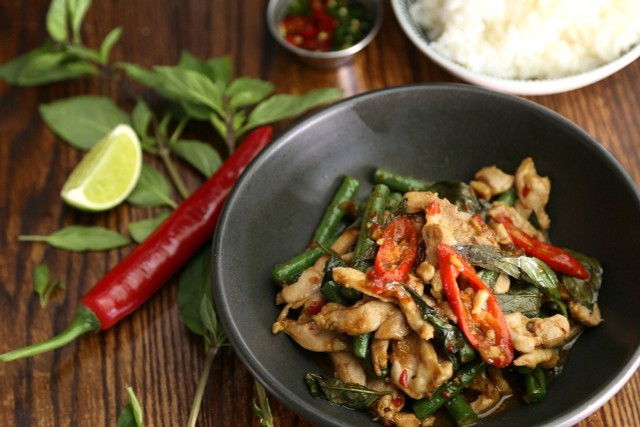
Thai basil is an aromatic spice with which you can refine savory and sweet dishes. We tell you how to best use the herb, grow it yourself and store it.
Thai basil: These varieties are available
As the name suggests, Thai basil is thought to have originated in southern Asia. In Europe, it also grows in the Mediterranean region. There are three different varieties: Bai Haropa is the best-known Thai basil variety.
Its taste is reminiscent of licorice and anise and has a dominant sweet aroma. Therefore, it is also known as “sweet basil”. You should not heat bai haropa, but use it only as a raw topping. As such, it is suitable for curries and other wok dishes, Thai soups, sauces or salads. Recipe ideas can be found here, for example: Wok recipes: Simple and quick dishes from the wok.
The Bai Maenglak variety also has a spicy flavor. Since its smell is reminiscent of lemons, you can also find it under the name “lemon basil”. You can also use this variety for Thai soups and stir-fries. Make sure to use it raw or to cook it only briefly.
Bai Krapao, also called “Holy Basil”, is best heated to fully enjoy its spicy aroma. Then this Thai basil reminds you of cloves and allspice. It is particularly suitable for sweet dishes and shakes with coconut milk.
Contents
Planting Thai basil: how to do it
If you want to grow Thai basil yourself, you should follow these tips:
- You can grow Thai basil either in a pot on the balcony or windowsill, or sow it in the garden outdoors. In any case, make sure that the plant is protected from wind and heavy rain.
- The soil should be rich in nutrients and humus and not too acidic. A gravel or clay content in the soil is also beneficial.
- Thai basil should only be sown in May after the Ice Saints. Scatter the seeds loosely on the ground and press them lightly. Make sure that they are not covered with soil – Thai basil is a light germinator.
- Water the herb regularly so that the soil is never completely dry. However, you should avoid waterlogging.
Thai basil care and propagation
Regarding care, overwintering and propagation of Thai basil you should also consider some essential aspects:
- Remove dead leaves regularly. Also, be sure to cut the plant back regularly if it becomes too bushy.
- Since Thai basil requires a lot of nutrients, it is important to fertilize the plant regularly. Plants in pots are best fertilized once a week. For outdoor plants, fertilizing every two to four weeks is sufficient. It is best to use a biodegradable liquid fertilizer. How you can easily make this yourself in various ways, we show you here: Fertilizer for plants: Make it yourself naturally
- When the first frost threatens, you should bring Thai basil indoors and place it in a frost-protected and light-flooded place.
- To propagate Thai basil, cut off the seeds just before the last frost and sow them next spring, starting in May.
- Alternatively, you can cut off some shoots and keep them in a water jar. The cuttings should soon have formed their own roots and can then be planted in a pot or outdoors.
Tips for storage and purchase

When you harvest Thai basil, you should always cut off whole stems, not just individual leaves. If you want to store the herb longer, you can freeze it. To preserve the aroma, do not wash the leaves before freezing. Alternatively, you can dry the leaves and store them in a cool place.
If you want to buy Thai basil, it is best to ask at your local Asian store. There you will usually find the herb in dried form. Sometimes you can also find fresh Thai basil in well-stocked grocery stores.

